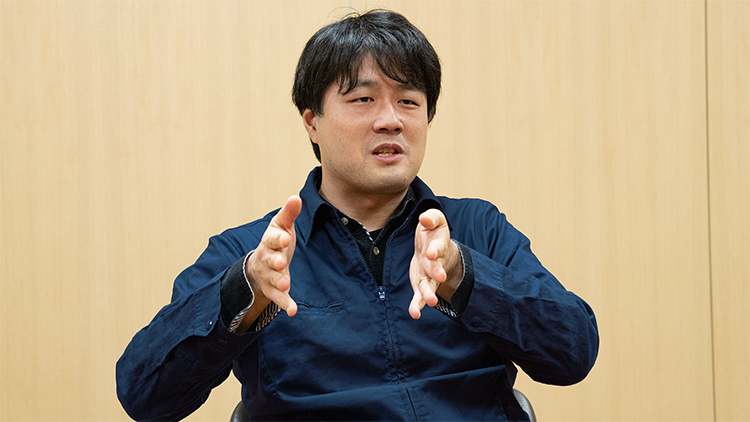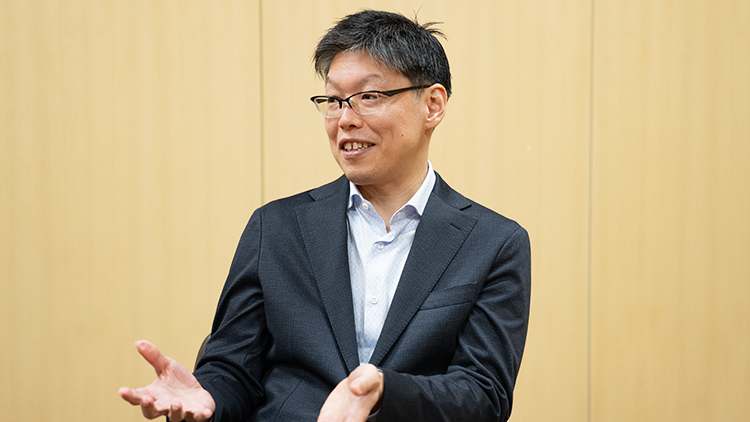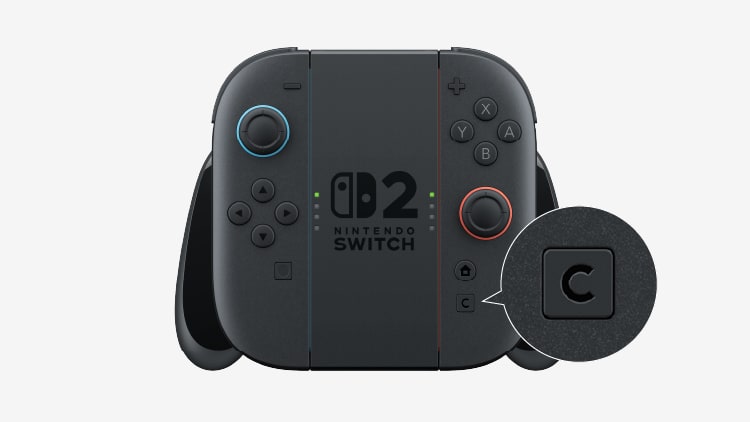
Ask the Developer Vol. 17: GameChat — Part 1
This article has been translated from the original Japanese content.
This interview was conducted before the system was released.
In this 17th volume of Ask the Developer, an interview series in which developers convey in their own words Nintendo's thoughts about creating products and the unusual details they hone in on, we're talking to the developers behind GameChat (1), a feature of Nintendo Switch™ 2.
(1) Additional games, systems and/or accessories may be required for multiplayer mode. Internet, Nintendo Switch Online membership and Nintendo Account required for online features, including GameChat. Compatible USB camera required for video features. Not available in all countries. Terms and GameChat requirements apply. support.nintendo.com Games, systems, membership and some accessories sold separately.
Check out the rest of the interview
Part 1: A defining feature
First, could you briefly introduce yourselves?
Sumikazu Ono (referred to as Ono from this point on): Hi, I’m Sumikazu Ono from the Entertainment Planning Department. I was the director in charge of overseeing the development of the Nintendo Switch 2 system's built-in features, in other words, the software that comes pre-installed on the console.
I’ve been working on the development of built-in hardware features ever since I started at Nintendo and, since joining the development of the Nintendo 3DS Activity Log as a programmer, I've always worked together with Tokunaga-san. For Nintendo Switch, I served as the programming director overseeing the built-in features, but this time, the scope of my responsibilities was even broader.
Eiji Tokunaga (referred to as Tokunaga from this point on): Hi, I’m Eiji Tokunaga from Nintendo Systems Co., Ltd. As the technical director for built-in features, I oversaw the development of the system software and servers required to run them. I’ve also been working on the development of system software since the days of Nintendo 3DS. Ono-san and I have been developing system software together on-site for a long time, so the fact we’re both now leading our own teams is a big deal for us.
Yoshitaka Tamura (referred to as Tamura from this point on): Hello. I’m Yoshitaka Tamura from the Technology Development Department. I was involved in the development of the Nintendo Switch 2 camera, sold separately, which plugs into the console. My role was to consider the camera's specifications based on what features it should have and how using it together with GameChat could offer players a better experience. In the past, I was involved in the development of motion IR cameras and HD rumble for controllers and accessories, and I also served as the project leader for Ring Fit Adventure (2).
(2) A Nintendo Switch game released in October 2019. In this fitness adventure game, you play by attaching Joy-Con™ controllers to the Ring-Con™ and Leg-Strap accessories that come with the software and moving your entire body.
Thank you. Let’s start with Ono-san. Could you give us an idea of what GameChat on Nintendo Switch 2 is?
Ono: GameChat is a voice and video chat feature that can be used with the Switch 2 system's built-in microphone. Other microphones, such as those in headsets, can be used too. What stands out is that each player can share their game screen with other players (3).
(3) Up to four people can share their screens in the same GameChat session.
Since GameChat is one of the built-in features, I assume that the GameChat project was running alongside the development of Switch 2. When did its development begin?
Ono: I believe development began around 2020 when we started thinking about what we could do with built-in features in the next hardware. At the time, I still didn’t know what the next hardware would be like, but I'd heard that the team was considering creating a Nintendo Switch successor. Then, Kawamoto-san (4) asked us, “Do you have any ideas for built-in features that would make the next hardware stand out?” As the team brainstormed, the idea of voice chat being a good pre-installed feature came up.
(4) Kouichi Kawamoto. The producer for Nintendo Switch 2. He was interviewed in Ask the Developer Vol. 16, Nintendo Switch 2.
With Nintendo Switch, you can access voice chat via the smartphone app and use it in supported games. What made you decide to have a built-in voice chat?
Ono: When Kawamoto-san asked us for ideas, he gave us the theme of a “student lounge.” A student lounge is a space where students gather and mingle. We were discussing how it would be nice to recreate that student lounge-like atmosphere, where everyone gathers not only to play games, but also just to hang out. The concept of the student lounge matched the idea of the built-in voice chat feature the team had in mind. Until now, online play for Nintendo games has meant everyone coming together to play the same game. But more than anything, we wanted to create a space where people would naturally gather, whether it's to play the same game together, or different games, or even just to watch. The team proposed that such a space would create a whole new way to voice chat, unlike Nintendo’s previous voice chats. This matched the theme of the “student lounge,” so we decided to create a prototype.

Tokunaga: Our team was also thinking of communication technology as the key to the next gaming console. Several of us had the same thing in mind and were each researching our own thing—some voice chat, some live streaming, others' microphones with noise cancellation. It was around that time that Ono-san approached me and asked whether it would be possible to implement a feature to facilitate player communication. I responded, “Actually, my team has been researching something similar. Why don’t we create a demo together?” From there, the first demo was completed rather smoothly, and we felt from a relatively early stage that this was going to be something good.
Ono: I was astonished to discover that Tokunaga-san’s team had already been conducting similar research. (Laughs) So, we decided to make a prototype, but at the time, Switch 2 hadn't even taken shape yet, so the research was done on a Switch console with increased memory and an improved CPU.
Because both teams had done so much research in advance, the prototype was completed in only six months, give or take.
Creating something that works in just six months sounds like a fairly quick turnaround. What was the hardware development team's involvement in the process?
Tamura: On the hardware development side, we’ve always kept up with the latest camera technology.
One day, we were told that a communication feature might be implemented in the Switch successor and that there might be a need for video chat as well as voice chat, so we started thinking about camera specifications accordingly. As mentioned earlier, the theme was a “student lounge,” so we thought it was important for the atmosphere in the room to carry over to other players. We saw the camera playing a key role, so we started to consider its specifications in earnest.
I see. It usually takes a lot longer to complete a prototype, but Ono-san and Tokunaga-san were both working separately on technical research aiming to achieve a similar goal, and at one point the three teams decided to join forces.
Tokunaga: That's right. It was the first time we'd ever completed a prototype so quickly. However...taking it from prototype to final product took an absolute age. (Laughs)
Everyone: (Laughs)
So GameChat ultimately became a key pillar among the built-in features of Switch 2, but was this something you had in mind from the beginning of development?
Ono: When we were developing GameChat, we had in mind that it would be a defining feature of Switch 2. During development, we had the opportunity for Nintendo executives to experience GameChat. Seeing them try out the feature for the first time and be able to video chat and share game screens smoothly gave us a certain confidence that this works.
Tokunaga: The executives were happily reminiscing about the development of the Super NES (5) and Nintendo 64 (6) games they were playing as they shared their screens. Seeing that made me realize this feature's potential.
(5) Super Nintendo Entertainment System™. A home video game console released in August 1991 in North America following the Nintendo Entertainment System™.
(6) A home video game console released in September 1996 in North America. It was the first home console from Nintendo with the ability to display large-scale 3D game environments. The controller was equipped with a 3D control stick that enabled player characters to move around freely in a 3D space.
Ono: But we felt we needed to dig deeper and fully explore the potential of game screen sharing by playing before we could feel confident of it truly becoming a defining feature of Switch 2. So, we spent about two hours every day playing various games while sharing screens via GameChat, and continued researching the kinds of situations in which it would be fun to use this feature.
I see. What have you discovered after trying out GameChat with various games?
Ono: Back then, we were still prototyping this feature on Switch, so we were testing GameChat with games that had already been released for Switch. One day, one of our team members was playing a puzzle game called Baba Is You (7), and the rest of us were curious to know what kind of game it was. The person who was playing the game shared their screen and said, “It's a game played with these rules."
And we were all like, “Wow, we didn’t know such an interesting puzzle game existed!” Fast forward a day and the whole team was playing it. (Laughs) That was a moment where game screen sharing really shone.
(7) Published by Hempuli. A puzzle game where you can change the rules by which you play. The rules are presented in each level as blocks that can be interacted with, and manipulating them changes how the level works, causing surprising, unexpected interactions. The Nintendo Switch version was released in March 2019 in North America.
Tokunaga: When I tried out GameChat with The Legend of Zelda: Breath of the Wild (8), what I found interesting was that I felt like I was playing an online game even though it isn't one.
(8) A single-player game released for Nintendo Switch and Wii U™ in March 2017. Awakening from a 100-year slumber, the protagonist, Link, must explore and survive the vast and dangerous land of Hyrule to regain his memories.
You felt like you were playing an online game, even though it isn't one? How do you mean?
Tokunaga: For example, suppose two friends are playing the game at their own pace, separately from one another. When one of them says, “I don't know how to solve this puzzle,” the other could say, “I'm on my way there, wait for me,” go to the same location in their own game and share their screen to demonstrate how to solve the puzzle. A phrase like, “I'm on my way there, wait for me” is something you don't hear when playing offline games. That's when I felt strongly that this feature could bring additional value to existing games.

Tamura: Sharing your game screen with others will make it easier to show them how to play a game. When playing a game for the first time, it’s easy to get lost, so I think players will appreciate being able to ask friends for help while playing together.
Ono: By trying out GameChat with various games and gradually discovering ways to utilize it in gameplay, we began to think that if we've already found so many interesting ways to enjoy it, players will find even more, and it's something that we can turn into one of the defining features of Switch 2.
So, you say that GameChat can add new value to existing games, but do you need anything else to enjoy this feature?
Ono: Well, ultimately, you'll need a Nintendo Switch Online membership (9) to use GameChat, but initially, until March 31, 2026, even non-members will be able to enjoy it as part of the GameChat Open-Access Period. With a Nintendo Switch Online membership, you can also access classic titles from NES (10), Super NES and more, so I think players will have a lot of fun using GameChat to play those games.
(9) Nintendo Switch Online is a paid membership service. Find out more about using GameChat on the official Nintendo Switch 2 website. GameChat Open-Access Period: until March 31, 2026, GameChat can be enjoyed for free. Afterwards, a Nintendo Switch Online membership will be required.
(10) Nintendo Entertainment System™. A home video game console released in October 1985 in North America. It came bundled with two controllers featuring a Control Pad with A and B Buttons. Players could swap game cartridges to play a variety of games.
Tamura: While we ourselves have seen how GameChat can expand the ways in which games can be enjoyed, we felt it was important to make the feature easy to use. Voice or video chat for gaming often involves a little extra work in setting up the equipment. But Switch 2 has a built-in microphone, so you can easily use voice chat, and the Nintendo Switch 2 camera, which is sold separately, is simple to use with a setup that is not too complicated. Thanks to increased hardware processing performance and yearly improvements in networking equipment and environments, we've finally reached the point where this feature can easily be realized.
That’s true. In the context of gaming, you might picture having a separate pair of headphones for voice chat. If you can get started without having to worry about that, I think it'll lower the barrier to entry for voice chat.
Ono: I think GameChat will encourage more players to try playing a game with voice chat for the first time. We knew a lot of players would eventually stop using this feature if it wasn't easy to understand, so we worked hard to ensure it could be used to easily play with friends and family without any fuss.
Tokunaga: One of the major features of GameChat is its ease of use.
Ono: We've added the C Button to the right Joy-Con 2, which players can press to instantly access GameChat whenever they feel like chatting.

Ono: I thought it would be bothersome to have to pause the game, go to the HOME Menu, set up the chat, and then return to the game every time you want to use the feature. So, we asked for a special button to be added while the hardware design was in progress. It was a very last-minute request, just before the controller molds were about to be made.
Tamura: But I think having the C Button was absolutely the right choice. Pressing the C Button to start a chat, operate the camera or adjust the settings is really intuitive, and I think it will create a completely new experience for players.
Tokunaga: Ultimately, we were able to implement a very simple control method that enables players to instantly start GameChat, simply by pressing the C Button, any time while they're playing.
Read more in Part 2: Festival vibes
